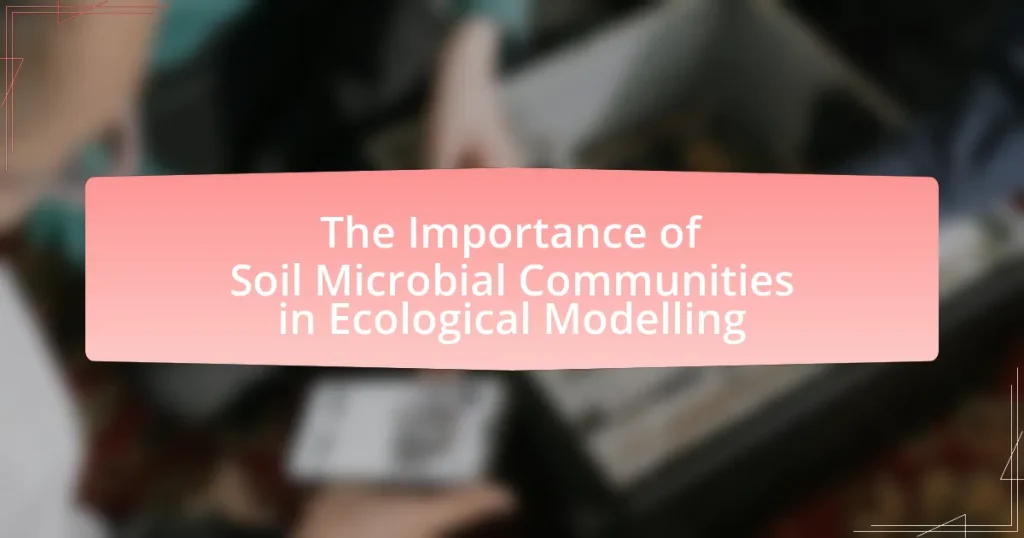Soil microbial communities, comprising diverse microorganisms such as bacteria, fungi, archaea, and protozoa, are essential for ecological modeling due to their significant influence on soil health, nutrient cycling, and organic matter decomposition. These communities contribute approximately 80% of soil nutrient availability, directly impacting plant growth and ecosystem productivity. Understanding their roles is crucial for predicting ecosystem responses to environmental changes, including climate change and land use alterations. The article explores the functions of soil microbial communities, their interactions with the environment, factors influencing their composition, and the implications for ecological modeling, emphasizing the need for accurate representation of microbial dynamics in ecological assessments.

What are Soil Microbial Communities and Why are They Important in Ecological Modelling?
Soil microbial communities are diverse assemblages of microorganisms, including bacteria, fungi, archaea, and protozoa, that inhabit the soil ecosystem. These communities play a crucial role in ecological modeling because they influence soil health, nutrient cycling, and organic matter decomposition, which are essential processes for ecosystem functioning. Research indicates that soil microbial activity contributes to approximately 80% of soil nutrient availability, directly affecting plant growth and ecosystem productivity. Additionally, microbial communities are sensitive indicators of environmental changes, making them valuable for predicting ecosystem responses to disturbances such as climate change and land use alterations. Their inclusion in ecological models enhances the accuracy of predictions regarding ecosystem dynamics and sustainability.
How do Soil Microbial Communities function within ecosystems?
Soil microbial communities function as essential components of ecosystems by facilitating nutrient cycling, decomposing organic matter, and enhancing soil structure. These communities, which include bacteria, fungi, and archaea, break down complex organic materials, releasing nutrients such as nitrogen and phosphorus that are vital for plant growth. Research indicates that soil microbes contribute to approximately 80% of the soil’s nutrient cycling processes, underscoring their critical role in maintaining ecosystem health. Additionally, these microorganisms form symbiotic relationships with plants, such as mycorrhizal associations, which improve water and nutrient uptake. This interdependence highlights the importance of soil microbial communities in sustaining biodiversity and ecosystem productivity.
What roles do different types of microorganisms play in soil health?
Different types of microorganisms play crucial roles in soil health by enhancing nutrient cycling, improving soil structure, and promoting plant growth. Bacteria decompose organic matter, releasing essential nutrients like nitrogen and phosphorus, which are vital for plant development. Fungi contribute to soil structure by forming mycorrhizal associations with plant roots, facilitating water and nutrient uptake. Additionally, actinomycetes produce antibiotics that suppress soil-borne pathogens, thereby protecting plant health. Research indicates that diverse microbial communities lead to increased soil fertility and resilience, as evidenced by studies showing that soils with higher microbial diversity exhibit better nutrient availability and plant productivity.
How do microbial interactions influence nutrient cycling?
Microbial interactions significantly influence nutrient cycling by facilitating the decomposition of organic matter and the transformation of nutrients. These interactions, such as competition, mutualism, and predation among microbial communities, enhance the availability of essential nutrients like nitrogen, phosphorus, and sulfur. For instance, nitrogen-fixing bacteria convert atmospheric nitrogen into forms usable by plants, while decomposer microbes break down organic materials, releasing nutrients back into the soil. Research indicates that diverse microbial communities can increase nutrient cycling efficiency, as shown in a study by van der Heijden et al. (2008) published in “Nature,” which found that soil microbial diversity positively correlates with nutrient availability and ecosystem productivity.
Why is understanding Soil Microbial Communities crucial for ecological modelling?
Understanding soil microbial communities is crucial for ecological modeling because these communities play a vital role in nutrient cycling, soil health, and ecosystem functioning. Soil microbes contribute to processes such as decomposition, organic matter breakdown, and nutrient availability, which directly influence plant growth and overall ecosystem productivity. Research indicates that microbial diversity and activity can significantly affect carbon sequestration and greenhouse gas emissions, making them essential for accurate climate models. For instance, a study published in “Nature” by van der Heijden et al. (2008) highlights how soil microbial communities enhance soil fertility and resilience, underscoring their importance in ecological assessments and predictions.
How do microbial communities affect ecosystem resilience?
Microbial communities enhance ecosystem resilience by promoting nutrient cycling, facilitating plant growth, and improving soil structure. These communities contribute to the stability of ecosystems by maintaining biodiversity and enabling rapid recovery from disturbances. For instance, studies have shown that diverse microbial populations can better withstand environmental stressors, such as drought or pollution, by providing essential functions like decomposition and organic matter formation. Research published in “Nature” by van der Heijden et al. (2008) indicates that soil microbial diversity is crucial for ecosystem productivity and resilience, demonstrating that ecosystems with rich microbial communities are more capable of recovering from perturbations.
What impact do they have on soil carbon storage?
Soil microbial communities significantly enhance soil carbon storage by facilitating the decomposition of organic matter and promoting the formation of stable soil organic carbon. These microorganisms break down complex organic materials, releasing nutrients that contribute to the accumulation of carbon in the soil. Research indicates that microbial activity can increase soil carbon sequestration by up to 30% in certain ecosystems, demonstrating their critical role in carbon cycling and storage.

How do Soil Microbial Communities interact with their environment?
Soil microbial communities interact with their environment primarily through nutrient cycling, decomposition, and symbiotic relationships. These communities break down organic matter, releasing essential nutrients like nitrogen and phosphorus back into the soil, which supports plant growth. For instance, studies have shown that soil bacteria and fungi decompose complex organic materials, enhancing soil fertility and structure. Additionally, these microorganisms form symbiotic relationships with plants, such as mycorrhizal associations, which improve water and nutrient uptake. Research indicates that these interactions significantly influence soil health and ecosystem productivity, demonstrating the critical role of microbial communities in maintaining ecological balance.
What factors influence the composition of Soil Microbial Communities?
The composition of soil microbial communities is influenced by factors such as soil type, moisture content, temperature, pH, organic matter availability, and land use practices. Soil type determines the physical and chemical properties that affect microbial habitat and nutrient availability. Moisture content influences microbial activity and diversity, as many microorganisms require specific moisture levels for optimal growth. Temperature affects metabolic rates and community structure, with different microbes thriving at varying temperatures. Soil pH impacts nutrient solubility and microbial community composition, as certain species prefer acidic or alkaline conditions. Organic matter availability serves as a carbon source for microbes, influencing their abundance and diversity. Lastly, land use practices, such as agriculture and urbanization, can alter microbial communities through changes in nutrient inputs and soil disturbance. These factors collectively shape the dynamics and functionality of soil microbial communities, which are crucial for ecosystem health and nutrient cycling.
How do land use and management practices affect microbial diversity?
Land use and management practices significantly influence microbial diversity by altering habitat conditions, nutrient availability, and soil structure. For instance, intensive agricultural practices, such as monoculture and heavy pesticide use, can reduce microbial diversity by creating a less varied environment and disrupting natural microbial communities. Research indicates that diverse land management strategies, like crop rotation and organic farming, enhance microbial diversity by promoting a wider range of habitats and resources for microorganisms. A study published in “Soil Biology and Biochemistry” by van der Heijden et al. (2008) found that diverse cropping systems support higher microbial diversity compared to conventional systems, demonstrating the critical role of land management in shaping microbial communities.
What role does climate change play in altering microbial communities?
Climate change significantly alters microbial communities by affecting their composition, diversity, and function. Increased temperatures and altered precipitation patterns can lead to shifts in microbial community structure, favoring certain species over others, which can disrupt ecosystem processes such as nutrient cycling and organic matter decomposition. For instance, studies have shown that rising temperatures can enhance the growth of thermophilic bacteria while reducing the abundance of mesophilic species, leading to changes in soil respiration rates and carbon storage. Additionally, changes in moisture levels can influence microbial activity and community dynamics, as some microbes thrive in wetter conditions while others prefer drier environments. These alterations can have cascading effects on soil health and ecosystem stability, highlighting the critical role of microbial communities in ecological modeling.
How can we measure the health of Soil Microbial Communities?
Soil microbial community health can be measured through various methods, including assessing microbial biomass, diversity, and activity. Microbial biomass can be quantified using techniques such as the chloroform fumigation-extraction method, which estimates the total microbial carbon present in the soil. Diversity can be evaluated through DNA sequencing techniques, such as metagenomics, which provide insights into the variety of microbial species present. Additionally, microbial activity can be measured by analyzing enzyme activities, such as dehydrogenase or phosphatase, which indicate metabolic processes and nutrient cycling. These methods collectively provide a comprehensive understanding of soil microbial community health, essential for maintaining soil quality and ecosystem functioning.
What methods are used to assess microbial diversity and function?
Methods used to assess microbial diversity and function include DNA sequencing, culture-based techniques, and metagenomics. DNA sequencing, particularly high-throughput sequencing, allows for the identification of microbial taxa and their relative abundances in environmental samples. Culture-based techniques, although limited, provide insights into the functional capabilities of specific microbial isolates. Metagenomics enables the analysis of genetic material directly from environmental samples, revealing functional genes and metabolic pathways present in microbial communities. These methods collectively enhance our understanding of microbial diversity and their ecological roles, as evidenced by studies demonstrating the correlation between microbial community composition and soil health indicators.
How do these measurements inform ecological models?
Measurements of soil microbial communities inform ecological models by providing critical data on nutrient cycling, organic matter decomposition, and ecosystem health. These measurements reveal the diversity and abundance of microbial species, which directly influence soil fertility and plant growth. For instance, studies have shown that specific microbial populations are essential for the breakdown of organic materials, thereby releasing nutrients that are vital for plant uptake. Additionally, quantifying microbial activity allows researchers to predict how changes in land use or climate may affect soil processes and overall ecosystem dynamics. This empirical data enhances the accuracy of ecological models by integrating biological interactions and feedback mechanisms that are crucial for understanding ecosystem responses to environmental changes.

What are the implications of Soil Microbial Communities for ecological modelling?
Soil microbial communities significantly influence ecological modeling by affecting nutrient cycling, soil health, and ecosystem dynamics. These communities play a crucial role in decomposing organic matter, which releases essential nutrients for plant growth and alters soil structure. Research indicates that microbial diversity enhances ecosystem resilience, as diverse communities can better adapt to environmental changes, thereby improving the accuracy of ecological models. For instance, a study published in “Nature” by van der Heijden et al. (2008) highlights how soil microbial diversity contributes to ecosystem functioning and stability, underscoring the necessity of incorporating microbial interactions into ecological models for more reliable predictions.
How do Soil Microbial Communities enhance predictive models?
Soil microbial communities enhance predictive models by providing critical data on nutrient cycling, organic matter decomposition, and soil health dynamics. These communities influence soil properties and ecosystem functions, which are essential for accurate modeling of ecological processes. For instance, studies have shown that incorporating microbial activity into models improves predictions of carbon sequestration and nutrient availability, leading to more reliable assessments of ecosystem responses to environmental changes. Research by De Vries et al. (2018) in “Nature Communications” demonstrated that models integrating microbial interactions yielded better forecasts of soil carbon dynamics compared to those that did not account for microbial contributions. This evidence underscores the importance of soil microbial communities in refining ecological models for better accuracy and relevance.
What specific modelling approaches incorporate microbial data?
Specific modelling approaches that incorporate microbial data include mechanistic models, statistical models, and machine learning models. Mechanistic models, such as the Soil Microbial Ecosystem Model (SMEM), simulate microbial processes based on biological and chemical interactions in the soil. Statistical models, like generalized additive models (GAMs), analyze relationships between microbial communities and environmental variables. Machine learning models, including random forests and neural networks, leverage large datasets to predict microbial community dynamics and their impact on soil health. These approaches are validated through empirical studies that demonstrate their effectiveness in predicting ecological outcomes influenced by microbial activity.
How can models be improved by integrating microbial interactions?
Models can be improved by integrating microbial interactions through enhanced accuracy in predicting ecosystem functions and responses. By incorporating microbial dynamics, models can better simulate nutrient cycling, organic matter decomposition, and plant-microbe interactions, which are critical for understanding soil health and fertility. Research indicates that microbial communities significantly influence soil properties and processes; for instance, a study published in “Nature” by van der Heijden et al. (2008) demonstrated that diverse microbial communities enhance ecosystem stability and productivity. Thus, integrating these interactions allows for more robust ecological models that reflect real-world complexities.
What challenges exist in incorporating Soil Microbial Communities into ecological models?
Incorporating soil microbial communities into ecological models presents several challenges, primarily due to their complex interactions and variability. Soil microbial communities are highly diverse and dynamic, making it difficult to accurately represent their functions and interactions within models. Additionally, the lack of comprehensive data on microbial diversity and activity limits the ability to parameterize models effectively. Research indicates that traditional ecological models often overlook the spatial and temporal variability of microbial communities, which can lead to inaccurate predictions of ecosystem processes (Schimel, 2018). Furthermore, the integration of microbial data into existing models requires interdisciplinary approaches, combining microbiology, ecology, and computational modeling, which can be resource-intensive and technically challenging.
What are the limitations of current modelling techniques?
Current modelling techniques in ecological modelling face several limitations, including oversimplification of complex biological interactions, inadequate representation of soil microbial diversity, and reliance on static parameters that do not account for dynamic environmental changes. These limitations hinder the accuracy and predictive power of models, as they often fail to capture the intricate relationships between soil microbial communities and ecosystem functions. For instance, many models do not incorporate the variability in microbial responses to environmental stressors, which can lead to significant discrepancies in predictions regarding nutrient cycling and soil health.
How can researchers overcome these challenges?
Researchers can overcome challenges in studying soil microbial communities by employing advanced molecular techniques and integrating interdisciplinary approaches. Utilizing high-throughput sequencing technologies allows for comprehensive profiling of microbial diversity, enabling researchers to capture the complexity of these communities. Additionally, incorporating data from soil chemistry, hydrology, and climate models enhances the understanding of microbial interactions and their ecological roles. Studies, such as those published in “Nature Reviews Microbiology,” demonstrate that combining these methodologies leads to more accurate ecological models, thereby validating the effectiveness of these strategies in addressing research challenges.
What best practices should be followed for studying Soil Microbial Communities in ecological modelling?
Best practices for studying soil microbial communities in ecological modeling include employing high-throughput sequencing techniques to accurately characterize microbial diversity, utilizing appropriate statistical models to analyze community structure and function, and integrating soil physicochemical properties to understand their influence on microbial dynamics. High-throughput sequencing, such as 16S rRNA gene sequencing, provides comprehensive insights into microbial taxa, while statistical models like generalized linear models can reveal relationships between microbial communities and environmental variables. Additionally, incorporating soil properties, such as pH and organic matter content, is essential for contextualizing microbial data, as these factors significantly affect microbial activity and community composition.


